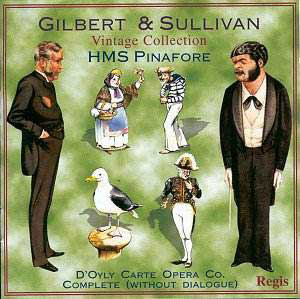Arthur Sullivan was Great Britain’s most important
composer of the Victorian age. Following a style of Mendelssohn mixed
with Balfe, Wallace, Offenbach, Auber and Adam he was well known for
his orchestral music and parlour ballads before the famous partnership
with Gilbert was cemented. As a composer he was skilled in providing
catchy melodies, songs that were well orchestrated and even led to the
cultivation of a new style of English operetta. This was kicked into
motion with Trial by Jury, an amusing curtain-raiser with bright
music. Its witty lyrics, colourful music and memorable tunes caught
the attention of an enterprising theatre manager, one Richard D'Oyly
Carte. Carte brought them together to write fourteen comic operas, the
third of which was HMS Pinafore.
HMS Pinafore is a two act comic opera
that followed the successful The Sorcerer. Gilbert’s libretto
pokes fun at regimental class division and rank. Its plot surrounds
a love affair between Ralph (a common sailor) and Josephine (a respectable
Captain’s daughter) which is interrupted by her father’s desire to see
Josephine married to Sir Joseph Porter (First Lord of the Admiralty).
The affair is stamped on by the Admiral until told that the Captain
and Ralph were mixed up as children and their ranks were swapped. This
turn of events now puts matters in a different light for Josephine is
now no Captain’s daughter but one of a common sailor instead. This will
not do for the Admiral (a caricature of Nelson) and so the proposed
marriage is called off. Thus, Josephine and Ralph can marry after all.
The rather eccentric plot is superbly held together by Gilbert’s witticisms
and Sullivan’s catchy score. The piece enjoyed a long initial London
run and set the scene for greater operatic delights to be known as the
Savoy Operas.
The recordings made in 1949 were amongst the first
of the D'Oyly Carte Opera Company’s post-war recordings. The company
had transferred their long-standing association with HMV (under Dr Sargent)
in the twenties and early thirties to Decca who released this set firstly
as 78 records, and later as LPs (initially for export for the American
market).
To lovers of G&S, the tempi of Sullivan’s musical
numbers is all important. Isidore Godfrey, D’Oyly Carte’s resident musical
director, understands Sullivan’s music particularly well and in his
many Decca recordings over the 1940s-60s the pace is usually spot on.
Decca doesn’t always provide him with a large orchestra yet in this
recording the playing is excellent. When a little over a decade later
Godfrey recorded a stereo version with dialogue the Penguin Guide awarded
its only rosette to Godfrey for this work. I find this performance matches
well with the later one, the only reservation being the less spacious
acoustics. However, the slight ‘boxiness’ to the sound here is in keeping
with the acoustic dynamics one would hear in theatre surroundings and
so should not be of real concern. From the well-played overture onwards
one is aware of the sensitive handling of musical dynamics not noticed
in the Glynebourne recordings of this vintage.
The D'Oyly Carte Opera Company existed continuously
from 1877 until 1982 and had a reputation for long-serving singers of
good voice and excellent diction. The singers we hear are those who
delivered their roles on stage and are thus memorable to the followers
of G&S as the company toured the country at this time. There would
be practically no break between touring and a week in the recording
studio so it is amazing that the voices don’t sound tired.
Muriel Harding is a clear-toned soprano and portrays
her role as Josephine with lyrical charm and good phrasing. Slight insecurity
causes some long-held high notes to waver, particularly in her second
aria ‘The hours creep on apace’ The tenor, Leonard Osborn (Ralph),
was a singer one either likes or dislikes. Here I find him very acceptable:
he sings confidently and his habit of exaggerated vibrato is not the
irritation it sometimes becomes.
The bass, Darrell Fancourt (Dick Deadeye), a favourite
amongst the D’Oyly Carte stars, is not given the opportunity in this
opera to convey all the qualities of his magnificent voice.
Martyn Green is D’Oyly Carte’s key patter man (Sir
Joseph Porter) of this period and doesn’t disappoint: his clear diction
and dry delivery is right for the part. Always a favourite in this role
his involvement will help to continue to sell this recording.
Leslie Rands (Captain) gives the vocal authority one
would expect from this part and Richard Walker (Boatswain’s mate) gives
appropriate support for the Act I trio.
There are excellent notes by James Murray. Why can’t
Decca provide this kind of detail in their notes for their current range
of D’Oyly Carte recordings from which they have amassed much profit?
The notes omits the masters’ matrix numbers and so it is not made clear
that this is a mono recording. The recording sessions were initially
cut as 78 masters, usually with two takes per side. Although by 1949
the tape recorder had been invented, Decca had not rushed into this
form of mastering since the reliability of tape had not been fully tested
at this time. Specially pressed acetate 78 records were used to make
the LP versions with a number of transcription units set up to allow
the LP master to be cut. This CD transcription from the LPs is excellently
equalised with good top and bottom frequencies.
There are other CDs of this recording:
One is the ‘Sounds on CD’ Pinafore issue VGS213
(released 2000). Taken from the 78s the equalisation is good and care
has been taken to reduce hiss.
Another recent issue is Pearl GEMS 0096 (released 2001).
Other releases in this series are–
The Pirates of Penzance (1949): Naxos 8.110196-7;
Pearl GEM 0097; SoundsOnCD VGS 231
The Mikado (1950): Regis RRC 2041; SoundsOnCD
VGS 221; Pearl GEMS 0134; Naxos 8.110176-77.
Raymond Walker


![]() See
what else is on offer
See
what else is on offer 